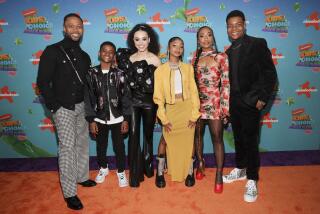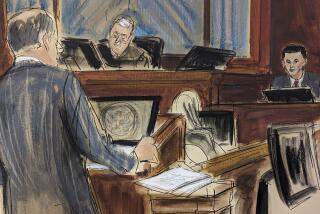Lay Admits Witness Contacts
- Share via
HOUSTON — A federal prosecutor rattled Kenneth L. Lay on Wednesday with a devastating cross-examination, showing that the former Enron Corp. chairman had repeatedly tried to contact actual and potential witnesses during his trial, even after lawyers warned him to stop.
Shaken and stuttering, Lay denied seeking to influence anyone’s testimony or, as prosecutor John C. Hueston put it, trying to “get his story straight.”
“I don’t have a story,” Lay declared. He said he merely wanted to make sure his own recollections were accurate.
Regardless of whether Lay violated any rules, he may have hurt his credibility with the jury and done collateral damage to his codefendant, former Enron Chief Executive Jeffrey K. Skilling, Houston trial lawyer Christopher J. Bebel said.
Lay’s defense team had been doing a good job of picking apart the government’s case, said Bebel, a former federal prosecutor. But “it seems all of that hard work may be washed away through these childish and irresponsible acts” by Lay, Bebel added.
Lay, 64, and Skilling, 52, face multiple counts of fraud and conspiracy arising from the 2001 collapse of Enron, an energy-trading colossus that once ranked among the nation’s most admired companies.
The South Texas jury of eight women and four men, whose attention seemed to be fitful during the first 2 1/2 days of Lay’s testimony, appeared riveted by the cross-examination, which began just after 3 p.m.
In the most dramatic hour of the 13-week trial, Hueston first questioned Lay about the witnesses, then confronted him with evidence that he probably had violated Enron’s code of ethics by not seeking permission from his board of directors before investing in a start-up company whose main customer was Enron.
Lay acknowledged that he should not have made the investment without first getting board approval.
Hueston also upbraided Lay for hypocrisy. Although he has complained of “character assassination” by the federal Enron Task Force, Hueston said, Lay stood alongside his chief lawyer, Michael W. Ramsey, last month as Ramsey called a government witness “a monkey” who “contradicted the theory of intelligent design.”
“I can’t take full responsibility for what my lawyers say,” Lay replied.
Hueston noted that the insults against the witness, former Enron Treasurer Ben F. Glisan Jr., came during sidewalk TV news conferences on successive days.
Wednesday’s fireworks followed long bouts of tedium, as Lay, under questioning by another defense lawyer, George McCall Secrest, moved glumly through the federal indictment. Lay denied the six allegations against him in detail and contradicted the testimony of a half-dozen government witnesses, including Glisan.
Secrest wrapped up by asking Lay whether he had tried his best to repay Enron the $7.5 million he still owed on a company line of credit that had been one of his perks as chairman.
Lay said that he had and was close to reaching a settlement before his July 2004 indictment. Staring at the prosecutor, Lay added: “John Hueston blocked that deal.”
Lay and Hueston have a history. Like the relentless Inspector Javert of “Les Miserables,” Hueston, 42, a marathon runner and a former assistant U.S. attorney in Orange County, has dogged the defendant’s footsteps for several years as the Enron Task Force’s Ken Lay specialist.
After saying, “Good afternoon, Mr. Lay,” Hueston quickly launched into his cross-examination.
Had Lay ever had a conversation with anyone about “getting your story straight?” Hueston asked. Lay denied it.
“Have you contacted witnesses to get your story straight?” Hueston asked.
“Uh, uh, uh -- I don’t know that I’ve contacted witnesses,” Lay said.
Hueston asserted that just after the end of testimony by the government’s star witness, former Enron Chief Financial Officer Andrew S. Fastow, Lay began trying to reach two executives at the investment banking firm of Goldman Sachs.
Fastow testified that he and Lay had spoken with the Goldman executives in September 2001. At the time, Fastow said, Enron was worried enough about its financial condition to discuss such options as selling its huge natural-gas pipeline system or even soliciting merger bids from another big company.
Lay denied Fastow’s account, testifying that the sole reason for the discussion was that the Goldman Sachs officials thought Enron’s stock was undervalued by the financial markets -- making the company vulnerable to an unwanted takeover bid.
The difference matters because Lay was making public statements at the time that Enron had never been stronger.
After Fastow’s testimony, Lay left several messages for the Goldman executives, Hueston said. The firm’s lawyers then called Lay’s legal team to warn him against further contact, the prosecutor said.
Nevertheless, Lay in early April called a friend in Goldman Sachs’ Houston office to pass on the message that Lay was anxious to reach the executives if they wanted to talk.
Again, Goldman’s lawyers asked that Lay back off. Lay testified that he didn’t recall the second warning.
“I was just trying to make sure I had my facts right,” Lay said.
Hueston asked whether Lay had tried to contact former Enron risk manager Wincenty “Vince” Kaminski the week before his testimony in early March.
Kaminski, a math whiz, testified that he had tried to warn Enron executives against establishing the now-notorious, off-the-books partnerships created and run by Fastow. The government contends that the Fastow partnerships were an accounting dodge meant to hide Enron losses and boost profit.
Lay said that when he tried to phone Kaminski, he didn’t realize he was a government witness. Hueston pointed out that Kaminski appeared on the prosecution’s official witness list.
Although he hadn’t seen Kaminski since Enron’s bankruptcy filing, Lay said he had “been trying to reconnect with Vince” for some time to talk about “general risk-management issues.”
“I enjoy Vince Kaminski,” Lay said. “I think most people do.”
More to Read
Inside the business of entertainment
The Wide Shot brings you news, analysis and insights on everything from streaming wars to production — and what it all means for the future.
You may occasionally receive promotional content from the Los Angeles Times.










